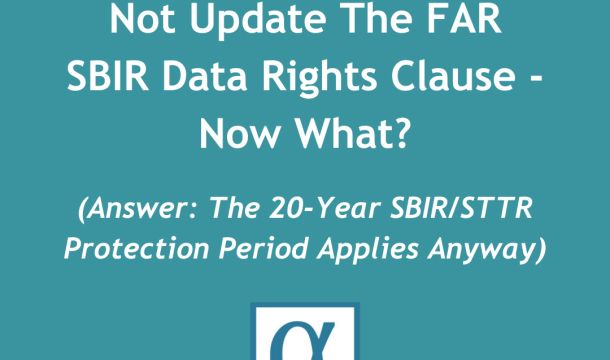The GovCon Bulletin™
New FAR Rule Provides Examples of Good Faith Effort to Meet Subcontracting Plan
On August 11, 2021, the U.S. Department of Defense, the General Services Administration, and the National Aeronautics and Space Administration issued a final rule (FAR Final Rule) implementing requirements under the National Defense Authorization Act for Fiscal Year 2017 (NDAA 2017) mandating that the Federal Acquisition Regulation (FAR) include examples of a failure to make a good faith effort to comply with a small business subcontracting plan.
FAR Part 19 requires large business prime contractors to submit small business subcontracting plans with their bids for negotiated contracts over $750,000 ($1.5 million for construction contracts) that have subcontracting possibilities. Absent some indication or demonstration by contractors that they made good-faith efforts to meet their subcontracting plan goals, contractors that do not comply with their plans face paying liquidated damages equal to their subcontracting goal short-falls.
NDAA 2017 required the U.S. Small Business Administration (SBA) to amend its regulations in order to include examples of activities that would be considered a failure to make a good faith effort to comply with a small business subcontracting plan. Consequently, in November 2019, the SBA issued a final rule that provided guidance for evaluating whether a prime contractor has made a good faith effort to comply with its small business subcontracting plan and that listed examples of activities reflecting a failure to make a good faith effort. The SBA’s final rule also required prime contractors with commercial subcontracting plans to include indirect costs in their subcontracting goals.
The changes made by the SBA to its regulations are now implemented in FAR by the FAR Final Rule. Specifically, as revised by the Final FAR Rule, FAR Part 19 now requires the subcontracting goal for a commercial plan to include all indirect costs, with certain exceptions that include depreciation, interest, income and property taxes, and bank fees. As revised, FAR Part 19 now also states that a contracting officer may consider any of the following, though not inclusive, to be indicators of a good faith effort:
(i) Breaking out work to be subcontracted into economically feasible units, as appropriate, to facilitate small business participation.
(ii) Conducting market research to identify potential small business subcontractors through all reasonable means, such as searching SAM, posting notices or solicitations on SBA's SUBNet, participating in business matchmaking events, and attending preproposal conferences.
(iii) Soliciting small business concerns as early in the acquisition process as practicable to allow them sufficient time to submit a timely offer for the subcontract.
(iv) Providing interested small businesses with adequate and timely information about plans, specifications, and requirements for performance of the prime contract to assist them in submitting a timely offer for the subcontract.
(v) Negotiating in good faith with interested small businesses.
(vi) Directing small businesses that need additional assistance to SBA.
(vii) Assisting interested small businesses in obtaining bonding, lines of credit, required insurance, necessary equipment, supplies, materials, or services.
(viii) Utilizing the available services of small business associations; local, state, and Federal small business assistance offices; and other organizations.
(ix) Participating in a formal mentor-protégé program with one or more small business protégés that results in developmental assistance to the protégés.
(x) Although failing to meet the subcontracting goal in one socioeconomic category, exceeding the goal by an equal or greater amount in one or more of the other categories.
(xi) Fulfilling all of the requirements of the subcontracting plan.
Under the Final FAR Rule, FAR states, conversely, that a contracting officer may consider any of the following, although not all inclusive, as indicators of a failure to make a good faith effort:
(i) Failure to attempt through market research to identify, contact, solicit, or consider for contract award small business, veteran-owned small business, service-disabled veteran-owned small business, HUBZone small business, small disadvantaged business, or women-owned small business concerns, through all reasonable means including outreach, industry days, or the use of Federal systems such as SBA's Dynamic Small Business Search or SUBNet systems.
(ii) Failure to designate and maintain a company official to administer the subcontracting program and monitor and enforce compliance with the plan.
(iii) Failure to submit an acceptable ISR, or the SSR, using the eSRS, or as provided in agency regulations, by the report due dates specified in 52.219-9, Small Business Subcontracting Plan.
(iv) Failure to maintain records or otherwise demonstrate procedures adopted to comply with the plan including subcontracting flowdown requirements.
(v) Adoption of company policies or documented procedures that have as their objectives the frustration of the objectives of the plan.
(vi) Failure to pay small business subcontractors in accordance with the terms of the contract with the prime contractor.
(vii) Failure to correct substantiated findings from Federal subcontracting compliance reviews or participate in subcontracting plan management training offered by the Government.
(viii) Failure to provide the contracting officer with a written explanation if the contractor fails to acquire articles, equipment, supplies, services, or materials or obtain the performance of construction work as described in FAR 19.704(a)(12).
(ix) Falsifying records of subcontract awards to small business concerns.
The requirements under the Final FAR Rule do not apply to contracts at or below the simplified acquisition threshold, but do apply to commercial contracts, including contracts for commercially-available off-the-shelf items. Prime contractors that have submitted subcontracting plans with their bids should take care to implement the new guidance under the Final FAR Rule in their contract administration policies and procedures.
The Final FAR Rule becomes effective September 10, 2021. To read the Final FAR Rule go here.
To read other articles from The GovCon Bulletin™ go here.



